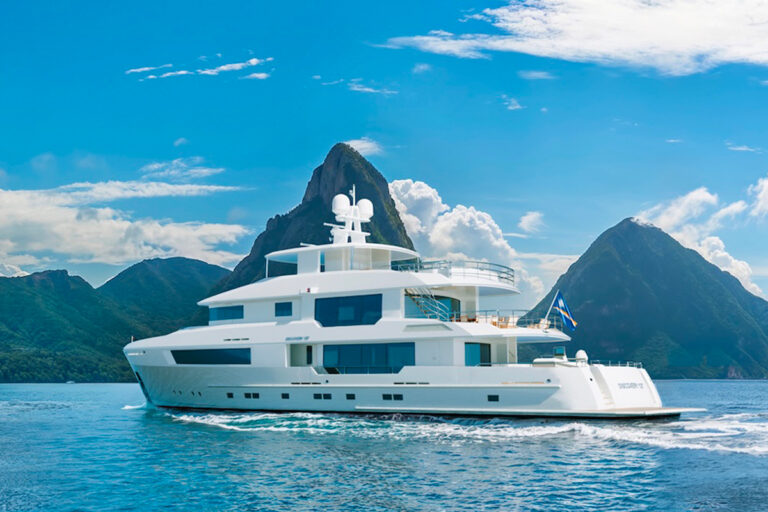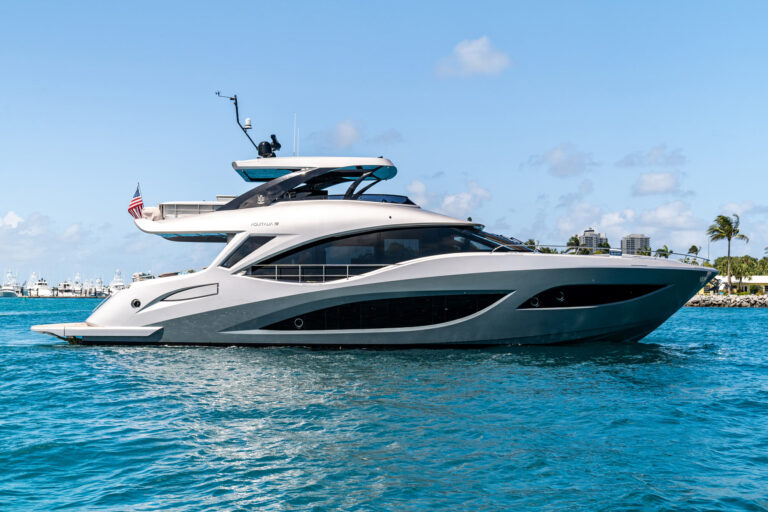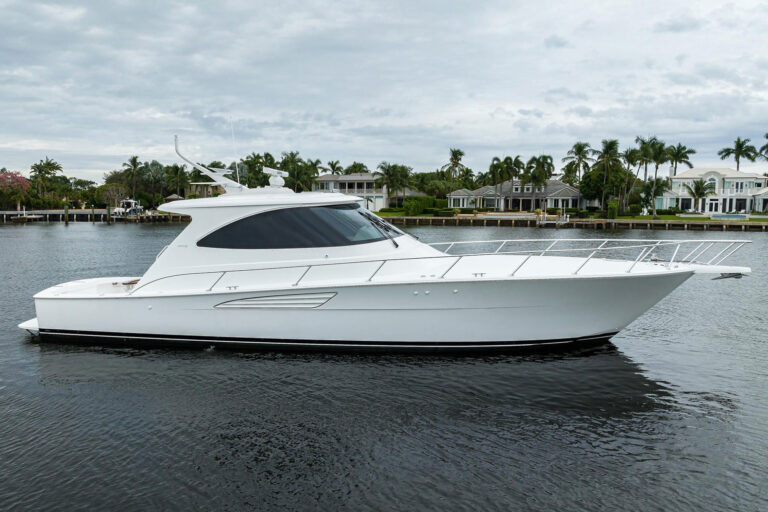Here’s what you get when you add 2.4 GHz and 160 MHz: a better marine VHF radio system, especially if you have been using Uniden’s new 525 VHF/DSC radio with one or two of the optional WHAM4X 2.4 GHz wireless microphones. By incorporating the 2.4 GHz radio technology used in its wireless telephones, Uniden has created a very useful system that can be controlled from the fixed mount base unit or from a handheld wireless remote that also functions as an intercom station.
The model 525 provides 56 transmit channels, 82 marine receive channels and 10 weather channels. A very easy to read LCD displays the channel in use in large numerals plus the status messages needed to program and operate the radio. The radio’s scanning protocols include triple-watch scanning of channels 9 and 16, plus the last working channel used, and a programmed selective scanning mode that searches selected channels while omitting channels 9 and 16. The radio’s receiver performance will be especially appreciated in areas where radio interference can be severe. The receiver’s selectivity and image rejection specification are an unusually high 80 dB.
All of the radio’s normal operational controls can be accessed from the wireless handset, including the automatic DSC enabled (channel 70) distress function. The 525 can be used with either one or two handsets, each of which will provide control of the radio, intercom between each handset and the base station, between handsets, or simultaneous communication with all stations. A second radio can be added to the network to provide the comprehensive VHF and intercom system appropriate for yachts with more than one maneuvering bridge.
Internal antennas serve the 2.4 GHz transceivers in the microphone and the base station. The communication range between the wireless units and the 525 will depend in part upon shielding caused by intervening metal surfaces, but on most boats will substantially exceed the length of the vessel. I was able to verify wireless mic to base station operation at a distance in excess of 70 meters and wireless to wireless range greater than 50 meters.
The digital selective calling (DSC) feature is a key part of the model 525. It must be connected to a GPS or Loran receiver to obtain the full capability of the DSC function for distress and routine hailing. A GPS “OK message appears on the LCD to confirm proper functioning of the GPS connection. The distress calling capability of the radio includes, in addition to the basic undesignated call, the ability to include information that designates the nature of the distress: fire, flooding, collision, grounding, capsizing, sinking, adrift, abandoning, piracy or man overboard. The operation of a VHF/DSC radio depends upon its ability to receive the digitally encoded hailing calls that are transmitted on channel 70. Therefore, the 525’s receiver continuously scans for the very brief DSC hailing signals that are transmitted on channel 70 except when a signal is being received on a distress/hailing channel or a working channel.
An incoming DSC distress call will immediately activate the radio’s distress alert functions, sounding an audio tone, displaying the incoming distress data on the LCD screen and entering the information into the 10-message capacity distress call memory. The radio can use its DSC hailing feature to initiate individual, group, all ships and position request calls. The operator can allow the radio to silently respond to received position request calls. Setting the DSC menu to “standby will prevent the radio from automatically switching to the channel designated by an incoming call and will inform the caller that the radio is unattended.
Weather channel monitoring goes beyond the norm in many VHF radios with inclusion of Specific Area Weather Alerting (SAME) capability, allowing the radio to be programmed so that it will alert only on those messages intended for the geographic area defined by the six-digit SAME code number.
The 525 includes a 20-watt audio amplifier dedicated to powering an external loudhailer. This can also function as a foghorn with a full range of manual or automatic fog signals. The sound pattern of the fog signal is controlled by selecting the appropriate vessel type, its sounding by vessel-movement information from the GPS. The foghorn program choices include selection of the sound frequency in 50 Hz steps. (Navigation Rules specify the frequency to be used as a function of length: 130 to 350 Hz for vessels longer than 75 but less than 200 meters, 250 to 700 Hz for vessels less than 75 meters in length.)
The WHAM4X microphone can control virtually all of the operating functions, including channel selection, squelch level, programming and use of dual/tri-watch scanning, assignment of channels for memory based scanning, access to weather channel scanning and the weather alert function, plus loudhailer and fog horn operation. The microphone also operates as an intercom, both with the main radio and with other WHAM4X units. The nine front-panel keys and the very readable LCD are illuminated for night use. The design of the radio system allows two model 525 radios-for example, one at the primary helm station, the second on the flybridge or tuna tower-to work with two WHAM4X hand-helds, one primarily used on deck, the other below. The guarded “distress button on the side of the handheld can initiate a DSC distress call. A jack on the mic’s top surface allows hands-free use with a voice-operated microphone/speaker (VOX operation). A bulkhead mounted holder that connects to the vessel’s 12-volt DC system is used to store the handset while its NiMH battery is recharged.
The radio measures only 6.6 x 4.4 x 5.2 inches deep and can be bracket or flush mounted. All controls, including the contrast setting for the LCD and the backlighting level for the LCD and push buttons, are easily adjusted. Both the radio ($200) and the wireless microphone ($130) are submersible to the JIS7 standard (one meter for 30 minutes).
Contact: Uniden, (800) 235-3874; www.uniden.com
Rock the Boat Listening to your favorite music on the water is one of the continuing pleasures of life. If you’re as serious about the quality of sound afloat as you are about taking your favorite tunes aboard, ASA/Jensen Marine, an international manufacturer and supplier of mobile audio and video equipment, has introduced two new products that are sure to please most every marine audiophile-the Jensen MS6505CS 61/2-inch Marine Component Speaker System ($130), and the Jensen JPort ($10), the connection that makes it easy to listen to iPod or other MP3 player tunes through your marine stereo system.
The 150-watt Jensen MS6505CS Speaker System includes two primary speakers with integrated woofers and two one-inch soft dome tweeters designed to separate the highs and lows of your songs more effectively and deliver full, rich sounds. With 50Hz to 20kHz of usable frequency response, 4 ohms of impedance and 150 watts of power, the MS6505CS is the right fit for those who like to rock the boat.
Magnetically shielded to prevent disruption of other marine instrumentation, and made with a UV-resistant polymer to resist discoloration and a corrosion resistant polypropylene woofer cone, the Jensen component speaker system is designed to withstand on-the-water usage. In accordance with U.S. Coast Guard standard 33CFR183.410.M, all Jensen Marine speakers are certified to be ignition protected against fire and spark hazards.
The Jensen JPort is a pre-wired cable and connectors that provide a direct audio interface between an MP3 player’s headphone output and the stereo’s auxiliary audio input. The JPort comes standard with a 9-foot RCA cable, so your player can be mounted in an optional bracket or tucked away.
Contact: ASA/Jensen Marine Audio, (574) 264-3135; www.asaelectronics.com









